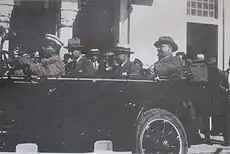Ali Çetinkaya
Ali Çetinkaya, also known as "Kel" Ali Bey (1878 – 21 February 1949) was an Ottoman-born Turkish army officer and politician, who served eight terms in the Grand National Assembly of Turkey, including a period in 1939–40 as his country's first Minister of Transport.
Ali Çetinkaya | |
|---|---|
 | |
| 1st Minister of Transport | |
| In office 3 April 1939 – 20 November 1940 | |
| President | İsmet İnönü |
| Prime Minister | Celâl Bayar |
| Preceded by | Office established |
| Succeeded by | Cevdet Kerim İncedayı |
| 10th Minister of Public Works | |
| In office 16 February 1934 – 3 April 1939 | |
| President | Mustafa Kemal Atatürk İsmet İnönü |
| Prime Minister | İsmet İnönü Celâl Bayar |
| Member of the Grand National Assembly | |
| In office 23 April 1920 – 5 August 1946 | |
| Constituency | Afyonkarahisar (1920, 1923, 1927, 1931, 1935, 1939, 1943) |
| Personal details | |
| Born | 1878 Karahisar-ı Sahib, Hüdavendigâr Vilayet, Ottoman Empire |
| Died | 21 February 1949 (aged 70–71) Istanbul, Turkey |
| Political party | Republican People's Party |
| Alma mater | Turkish Military Academy |
| Military service | |
| Allegiance | |
| Branch/service | |
| Rank | Brigadier |
| Commands | 172nd Regiment |
| Battles/wars | |
Biography
He was born in Kara Hisâr-i Sâhib (present day Afyonkarahisar) in Hüdavendigâr Vilayet as the son of Ahmed Efendi. He studied in the Bursa Military High School (Bursa Askerî İdadisi ). After graduating from military highschool, he entered the Ottoman Military Academy (Mekteb-i Füsûn-u Harbiyye-i Şâhâne ) In 1898 he graduated academy and joined the Ottoman military as a Second Lieutenant (Mülâzım-ı Sani ). During World War I, he served for the army in the Caucasus and Galicia fronts.
When the Greek forces were landing at Smyrna on May 15, 1919, he was a lieutenant colonel and the commander of 172nd Infantry Regiment stationed in the Aegean coastal town of Ayvalık. His regiment was under the command of the 56th Division of Hürrem Bey. Ali played a key role in the first stage of the Greco-Turkish War of 1919–1922, starting with the opening battle.
He was briefly able to hold back the advance into the city of Greek occupation forces. His action is considered to mark the first shots fired by regular forces in the 1919–22 Greco-Turkish War, although there were earlier confrontations in which irregular militias participated, including the battle involving Hasan Tahsin in İzmir, as well as actions in Urla and Ödemiş. The hill in Ayvalık from where the first shots were fired is now called İlk Kurşun Tepesi (First Bullet Hill). Today there is a military rehabilitation center on that hill.
After the war, Ali Çetinkaya was elected to Turkish Grand National Assembly for eight successive terms and served until 1942, holding ministerial posts in six different governments, including, with the formation of a Ministry of Transport, becoming Turkey's first Minister of Transport.
Ali Çetinkaya died in Istanbul in the year of his 71st birthday.
Ali Çetinkaya is considered a hero in Turkey. Cunda Island of Ayvalık was renamed Alibey Adası (Ali Bey Island) after him, although the old name remains in common use.
 Another image of Ali Çetinkaya in the 1920s
Another image of Ali Çetinkaya in the 1920s Three members of the Independence Tribunal
Three members of the Independence Tribunal
References
External links
- Hasan Kundakçı, "Ali Çetinkaya'yı Anarken", Atatürk Araştırma Merkezi Dergisi, Sayı 38, Cilt: XIII, Temmuz 1997 (in Turkish)